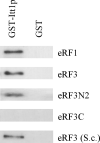Itt1p, a novel protein inhibiting translation termination in Saccharomyces cerevisiae
- PMID: 11570975
- PMCID: PMC56590
- DOI: 10.1186/1471-2199-2-9
Itt1p, a novel protein inhibiting translation termination in Saccharomyces cerevisiae
Abstract
Background: Termination of translation in eukaryotes is controlled by two interacting polypeptide chain release factors, eRFl and eRF3. eRFl recognizes nonsense codons UAA, UAG and UGA, while eRF3 stimulates polypeptide release from the ribosome in a GTP- and eRFl - dependent manner. Recent studies has shown that proteins interacting with these release factors can modulate the efficiency of nonsense codon readthrough.
Results: We have isolated a nonessential yeast gene, which causes suppression of nonsense mutations, being in a multicopy state. This gene encodes a protein designated Itt1p, possessing a zinc finger domain characteristic of the TRIAD proteins of higher eukaryotes. Overexpression of Itt1p decreases the efficiency of translation termination, resulting in the readthrough of all three types of nonsense codons. Itt1p interacts in vitro with both eRFl and eRF3. Overexpression of eRFl, but not of eRF3, abolishes the nonsense suppressor effect of overexpressed Itt1p.
Conclusions: The data obtained demonstrate that Itt1p can modulate the efficiency of translation termination in yeast. This protein possesses a zinc finger domain characteristic of the TRIAD proteins of higher eukaryotes, and this is a first observation of such protein being involved in translation.
Figures




Similar articles
-
Modulation of efficiency of translation termination in Saccharomyces cerevisiae.Prion. 2014;8(3):247-60. doi: 10.4161/pri.29851. Epub 2014 Nov 1. Prion. 2014. PMID: 25486049 Free PMC article. Review.
-
Elongation factor eEF1B modulates functions of the release factors eRF1 and eRF3 and the efficiency of translation termination in yeast.BMC Mol Biol. 2009 Jun 22;10:60. doi: 10.1186/1471-2199-10-60. BMC Mol Biol. 2009. PMID: 19545407 Free PMC article.
-
Yeast polypeptide chain release factors eRF1 and eRF3 are involved in cytoskeleton organization and cell cycle regulation.Cell Motil Cytoskeleton. 2002 Jul;52(3):161-73. doi: 10.1002/cm.10040. Cell Motil Cytoskeleton. 2002. PMID: 12112144
-
Ribosome-bound Pub1 modulates stop codon decoding during translation termination in yeast.FEBS J. 2017 Jun;284(12):1914-1930. doi: 10.1111/febs.14099. Epub 2017 May 29. FEBS J. 2017. PMID: 28467675
-
Termination of translation in eukaryotes.Biochem Cell Biol. 1995 Nov-Dec;73(11-12):1079-86. doi: 10.1139/o95-116. Biochem Cell Biol. 1995. PMID: 8722024 Review.
Cited by
-
The major 5' determinant in stop codon read-through involves two adjacent adenines.Nucleic Acids Res. 2004 Jan 21;32(2):415-21. doi: 10.1093/nar/gkh201. Print 2004. Nucleic Acids Res. 2004. PMID: 14736996 Free PMC article.
-
Modulation of efficiency of translation termination in Saccharomyces cerevisiae.Prion. 2014;8(3):247-60. doi: 10.4161/pri.29851. Epub 2014 Nov 1. Prion. 2014. PMID: 25486049 Free PMC article. Review.
-
Eukaryotic release factor 1-2 affects Arabidopsis responses to glucose and phytohormones during germination and early seedling development.J Exp Bot. 2010;61(2):357-67. doi: 10.1093/jxb/erp308. Epub 2009 Nov 25. J Exp Bot. 2010. PMID: 19939886 Free PMC article.
-
Mutants of the Paf1 complex alter phenotypic expression of the yeast prion [PSI+].Mol Biol Cell. 2009 Apr;20(8):2229-41. doi: 10.1091/mbc.e08-08-0813. Epub 2009 Feb 18. Mol Biol Cell. 2009. PMID: 19225160 Free PMC article.
-
Termination of translation: interplay of mRNA, rRNAs and release factors?EMBO J. 2003 Jan 15;22(2):175-82. doi: 10.1093/emboj/cdg017. EMBO J. 2003. PMID: 12514123 Free PMC article. Review.
References
-
- Frolova L, Le Goff X, Rasmussen HH, Cheperegin S, Drugeon G, Kress M, Arman L, Haenni AL, Celis JE, Philippe M, Justesen J, Kisselev LL. A highly conserved eukaryotic protein family possessing properties of polypeptide chain release factor. Nature. 1994;372:701–703. doi: 10.1038/372701a0. - DOI - PubMed
-
- Frolova L, Simonsen JL, Merkulova TI, Litvinov DY, Martensen PM, Rechinsky VO, Camonis JH, Kisselev LL, Justesen J. Functional expression of eukaryotic polypeptide chain release factors 1 and 3 by means of baculovirus/insect cells and complex formation between the factors. Eur J Biochem. 1998;256:36–44. doi: 10.1046/j.1432-1327.1998.2560036.x. - DOI - PubMed
Grants and funding
LinkOut - more resources
Full Text Sources
Molecular Biology Databases

